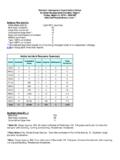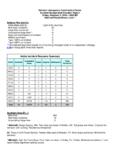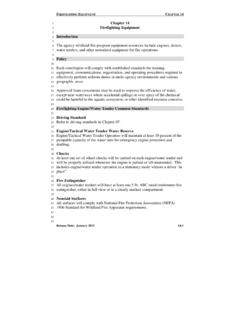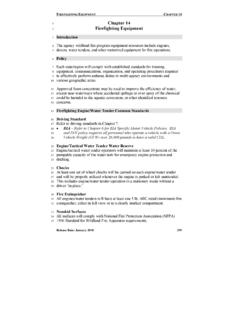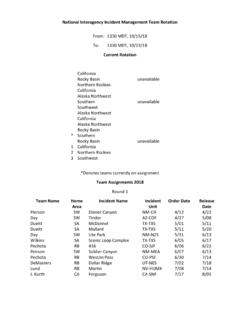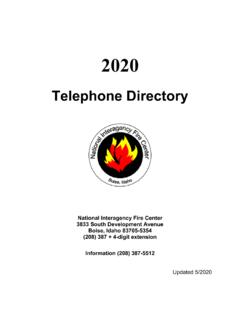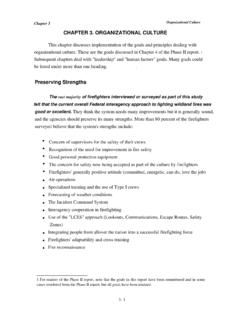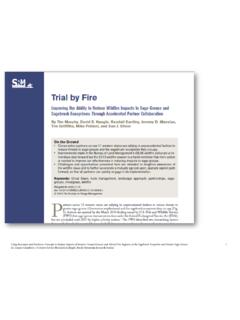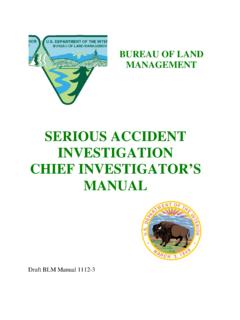Transcription of National Significant Wildland Fire Potential Outlook
1 National Significant Wildland Fire Potential Outlook Predictive Services National Interagency Fire Center Issued: October 1, 2020 Next Issuance: November 1, 2020 Outlook Period October, November, and December 2020 through January 2021 Executive Summary The Significant Wildland fire Potential forecasts included in this Outlook represent the cumulative forecasts of the ten Geographic Area Predictive Services units and the National Predictive Services unit. A heat wave developed across the West Coast during the first week of September that resulted in hot, dry, and unstable conditions with explosive large fire growth.
2 The Creek Fire in southern California produced multiple pyrocumulonimbus clouds including lightning and the first two pyrotornadoes ever surveyed by the National Weather Service (NWS). Fire activity also increased across much of the West in response to the heat wave and very dry fuels. Multiple wind events resulted in Significant large fire activity including a historic offshore wind event that began Labor Day and continued during the following few days. Rapid fire spread and extreme fire behavior developed on numerous new and existing large fires in Washington, Oregon, and California.
3 Other notable wind events led to Significant increases of fire activity in Montana and California early and late in September, respectively. Air quality and smoke concerns were greatly exacerbated on the West Coast and eventually most of the West for much of September. However, a series of upper-level troughs produced wetting rain across portions of the Pacific Northwest and Northern Rockies later in the month. This helped reduced fire activity and Significant fire Potential late in the month across these regions.
4 A pause in fire activity was observed in the Rocky Mountain Area due to cold, wet conditions during the week of Labor Day, but rebounded later in the month. La Ni a and current fuel conditions are the main drivers of Significant fire Potential through fall and into winter. Drought conditions are expected to continue for much of California, the Great Basin, and the Southwest through October with drying expected to increase across portions of the southern Plains and Southeast. Significant fire Potential remains above normal for California due to the number of active large fires, near record dry fuels, and offshore wind events.
5 Above normal Significant fire Potential is expected across much of California, Arizona, eastern Nevada, Utah, Colorado Rockies, and southern Wyoming in October. However, fire activity and Potential will likely diminish across the West, except for portions of California, and remain normal over the Eastern and Southern Areas through November. Elevated periods of fire activity are likely in portions of Oklahoma and Texas and possibly in other locations in the Southern Area during fall into winter.
6 Past Weather and Drought September began with strong upper-level ridging over the West and above average to record setting temperatures across large portions of the region, especially from the Desert Southwest into the Pacific Northwest. Due to the hot, dry, and unstable conditions, multiple large fires produced pyrocumulonimbus clouds including the Creek Fire in California where the NWS surveyed the first ever pyrotornadoes. A wind event in early September resulted in multiple large fires in Montana while periodic hot, dry, and windy conditions fueled growth on large fires in Wyoming and Colorado.
7 A strong upper-level trough began to move southward into the Intermountain West on Labor Day before stalling out near the Four Corners region. Extremely strong east-northeast, offshore winds developed amid a dry airmass along the length of the West Coast resulting in historic wind-driven fire activity. Also during this event, precipitation, including snow at higher elevations, fell across the Rocky Mountains and the Plains, which helped temporarily dampen fire danger across these areas. Tropical Storm Beta made landfall at Matagorda Bay in Texas on September 21 and brought heavy rainfall to portions of east Texas, the Lower Mississippi Valley, Tennessee Valley, and Southeast.
8 Warm and dry conditions continued across much of New England, which led to several days of higher fire danger. A series of upper-level troughs moved through the Pacific Northwest and Northern Rockies towards the end of the month resulting in wetting rain across much of the region and significantly lower fire danger in Washington, western Oregon, the Idaho Panhandle, and northwest Montana. While lightning was relatively infrequent during September, widely scattered dry thunderstorms resulted in an increase of initial attack and new large fires for portions of the Southwest, Great Basin, Rocky Mountain, and Northern Rockies areas on September 21-24.
9 As a cold front pushed south through the West during the last weekend of September, another round of strong offshore winds developed resulting in extreme behavior and rapid fire spread in northern California, including new large fires that remain active. Left: Departure from Normal Temperature (top) and Percent of Normal Precipitation (bottom) (from High Plains Regional Climate Center). Right: Drought Monitor (top) and Drought Outlook (bottom) (from National Drought Mitigation Center and the Climate Prediction Center) Weather and Climate Outlooks La Ni a developed in September with below average sea surface temperatures (SSTs) in the equatorial east-central and eastern Pacific Ocean.
10 The Climate Predicter Center (CPC) forecasts a 75% chance that La Ni a conditions will continue through the winter. La Ni a has the Potential to significantly impact the fall fire season in California by producing persistent drier than average conditions along with a possible higher frequency of wind events. Warmer and drier conditions are also likely to continue for much of the Great Basin and Southwest through the fall. Drier than average conditions may also develop across the Southeast this fall and winter.
